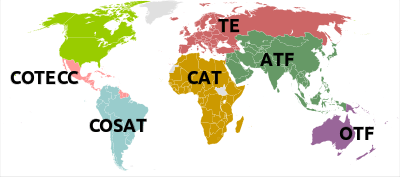Asian Tennis Federation
The Asian Tennis Federation (ATF) is a non-profit organization affiliated with the International Tennis Federation. It is a continental body of national tennis associations of Asian countries. The ATF's main objectives are to raise the quality standard of Asian tennis and to popularize tennis sport among the peoples of Asia. There are currently 44 member associations who represents their respective nations. The ATF works closely with the International Tennis Federation (ITF) and supports its member associations through the implementation of a wide range of programs.
 | |
 Members of ATF | |
| Type | Sport Association |
|---|---|
| Headquarters | Continental Federations |
| Location |
|
Region served | Asia |
Membership | 44 Asian nations |
President | Anil Khanna |
| Website | asiantennis.com |
Board of directors
The board of directors is the elected group of members from national tennis bodies of Asian nations, the current list of members is:[1]-
| Name | Designation |
|---|---|
| Anil Kumar Khanna | President |
| Sheikh Ahmad Al–Jaber Al Sabah | Honorary Chairman |
| Martina Widjaja | Vice President
(Juniors & Development) |
| Syed Dilawar Abbas | Vice President
(South Asia) |
| Sun Jin-fang | Vice-President
(East Asia) |
| Suwat Liptapanlop | Vice-President
(South-East Asia) |
| Nasser Al-Khelaifi | Vice-President
(West Asia) |
| Shomurad Shofayziev | Vice President
(Central Asia) |
| Surendran Subramaniam | Honorary Secretary General |
| Ishtiaq Ahmed | Member |
| Ajay Pathak | Member |
| Alizera Khorooshi | Member |
| Naohiro Kawatei | Member |
| Adil Burlibayev | Member |
Challenges
Asia is by far the most populous continent but tennis still remains a sport under development. Besides a couple of Asian nations like India, China and Japan who have produced some world class players, tennis does not have a very long and fruitful history. The only Asian to ever win a single tennis grand slam is Chinese women Li Na, who won both the woman’s French Open 2011 and Australian Open 2014, with over 100 million people watching in China. She grew up playing badminton and only switched over to tennis because a coach saw her potential for the sport. But the backward Chinese tennis coaching she received in her early days actually turned her against the game and she eventually quit for two years only to come back when China tennis authorities allowed her to take the reins and hire a coach to her liking without regards of the costs. After Li Na had won the two grandslam tournaments, everyone start to know tennis in China. Especially in a country like China interest in the tennis sport is very much at the lead level compared to other Asian countries. If you weren't a lead level player, maybe you are wasting your time, taking away from study or education. But we've really seen in the last couple of years that mindset changing, in China in particular, Ben Slack, Tennis Australia's head of international business.
The Women's Tennis Association announced in 2017 that it has signed a 10-year deal to move its finals tournament to Shenzhen, a dynamic city in China south, starting from next year. The deal will also see the total prize money on offer double to a whopping US$14 million.
Tennis is expensive and most Asian countries are still a developing economy, which means the standard of living is comparatively less and people spend their money on necessities rather than tennis racquets. There are currently 289 futures and challengers in a year in Europe, while Asia in comparison only has 61 of these tournaments. Even South America has 81, where there are only ten states and where players from the other continents rarely go due to remoteness.[2] The number of tournaments in Asia is increasing and with it the level of the sport. In the next 10 years, the Asian region, should produce some exciting players.
Sponsors of ATF
This is a list of official sponsors of ATF:[3]
- Wilson
- California Products – Official Supplier of Court Surfaces
- Yonex – Official Racket of the Asian Tennis Federation
- Rebound Ace
- All India Tennis Association
- Lawn Tennis Association of Thailand
- Sri Lanka Tennis Association
- Qatar Tennis Federation
- Uzbekistan Tennis Federation
References
- "ATF Executives". Archived from the original on 2011-07-07. Retrieved 2011-02-06.
- "Among tennis leaders of the continent". UTF. Retrieved 2011-02-06.
- "Sponsors". Archived from the original on 2011-07-07. Retrieved 2011-02-06.
